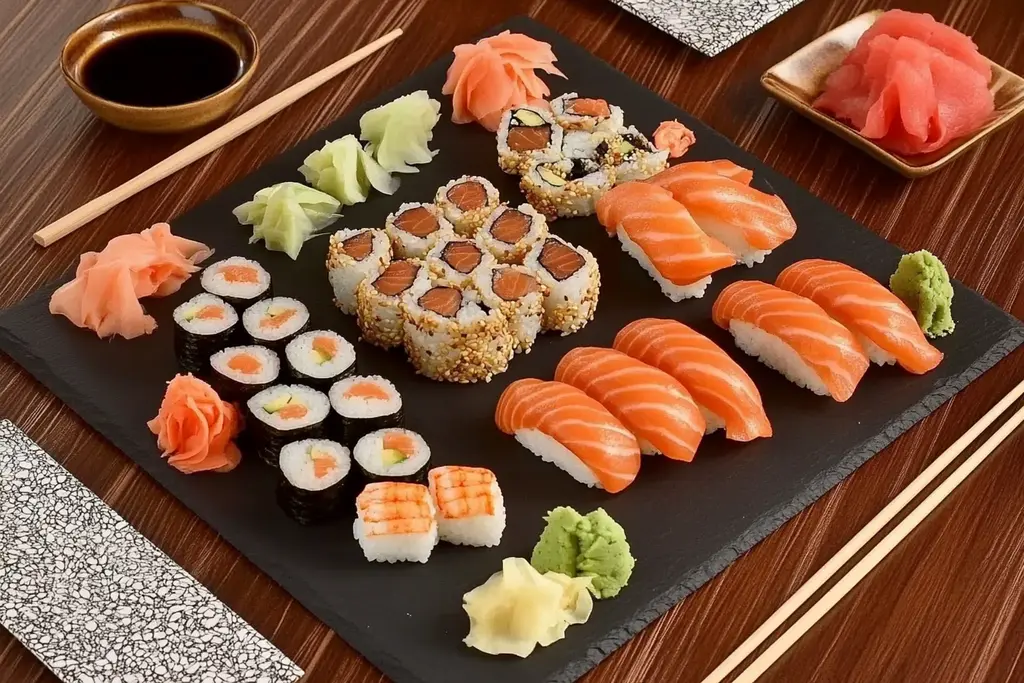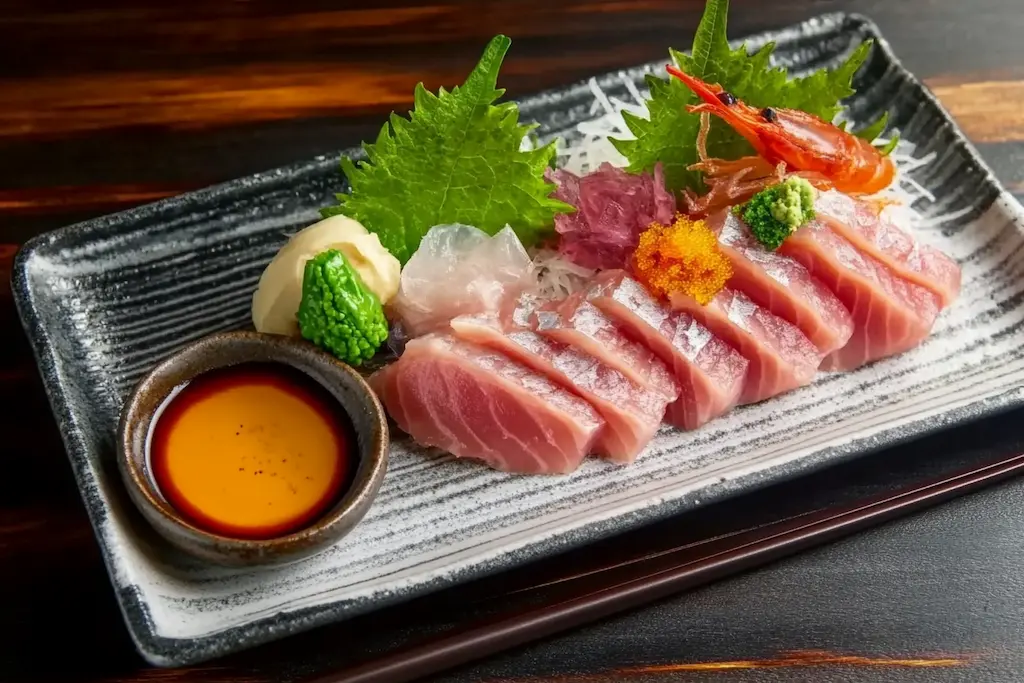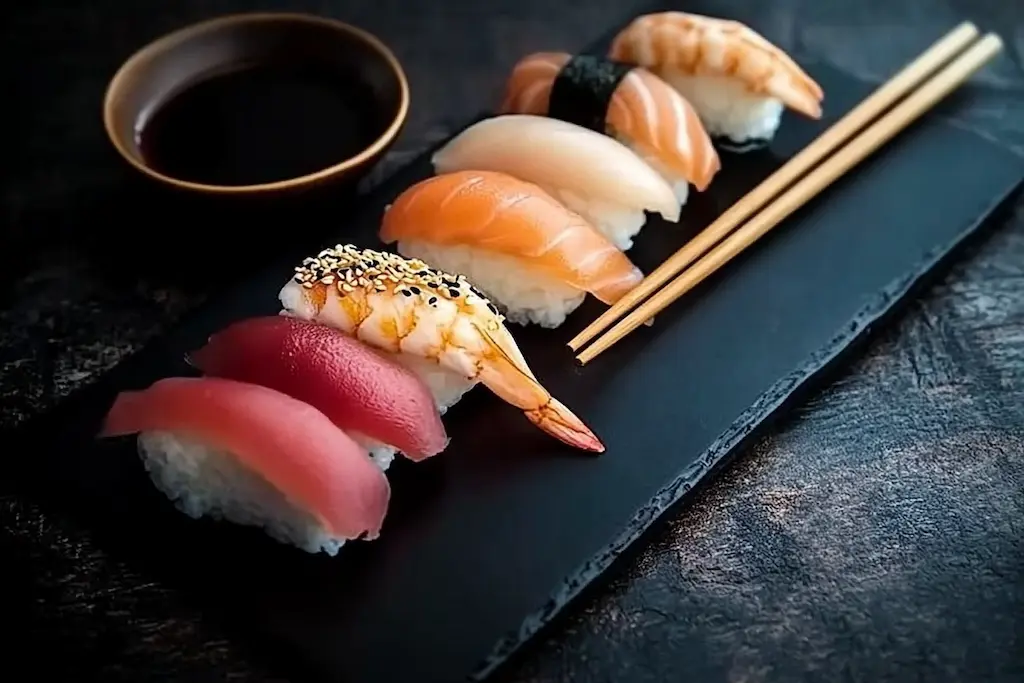Japanese cuisine is a world of artistic expression, precision, and tradition. Among its most iconic culinary offerings are sashimi and nigiri, two dishes that capture the essence of freshness and simplicity. But what exactly separates these two delicacies? If you’ve ever puzzled over the difference while perusing a sushi menu, you’re not alone! Let’s dive in to uncover the contrasts and subtleties between sashimi and nigiri.
Understanding Japanese Cuisine Basics
Japanese cuisine is not just about food—it’s a cultural phenomenon. The balance between aesthetics, texture, and flavor is unmatched. Every dish tells a story, and this is especially true for sashimi and nigiri. But before we get into the details, it’s important to grasp the underlying philosophy of Japanese cooking.
Japanese cuisine is built on three pillars: simplicity, seasonality, and respect for ingredients. Whether it’s the delicate slicing of sashimi or the meticulous shaping of rice for nigiri, these principles shine through.
The Cultural Importance of Sashimi and Nigiri
In Japan, meals are more than just sustenance; they are ceremonies of taste. Sashimi, often served as the first course in traditional meals, is considered a mark of sophistication and craftsmanship. On the other hand, nigiri, with its harmonious pairing of vinegared rice and fresh seafood, exemplifies the art of sushi-making.
Both dishes serve as reminders of Japan’s deep connection to the sea and its seasonal bounty. No wonder they’ve become global ambassadors of Japanese cuisine!

Key Ingredients in Japanese Sushi Traditions
What makes Japanese cuisine so unique? It’s all about the quality of the ingredients. Sashimi relies on premium-grade fish or seafood, sliced with precision to highlight its natural flavors. Nigiri, while similar in its use of fish, introduces vinegared rice as the base, creating a delicate contrast between flavors and textures.
In both cases, freshness isn’t just preferred—it’s mandatory. Would you wear sunglasses on a rainy day? Exactly. The same logic applies here.
Defining Sashimi: A Pure Art Form
What Qualifies as Sashimi?
Sashimi is raw fish or seafood served without rice. It’s all about showcasing the natural flavors of the fish, so sauces and garnishes are kept minimal. Thin slices of tuna, salmon, or even octopus are arranged with a focus on aesthetics.
One way to think of sashimi? It’s like the supermodel of the Japanese food world—elegant, raw, and impossible to ignore.
The Role of Freshness in Sashimi Preparation
Freshness is king when it comes to sashimi. The fish needs to be of the highest quality because there’s nothing to mask its taste. Chefs often source their ingredients directly from trusted fish markets.
One bite of fresh sashimi feels like dipping your toes in a crystal-clear ocean. It’s clean, light, and pure. Who wouldn’t want that?
Popular Types of Sashimi
Not all sashimi is created equal. Some of the most beloved varieties include:
- Maguro (Tuna): Rich and meaty, this is a classic choice.
- Sake (Salmon): Known for its buttery texture.
- Tako (Octopus): Chewy and slightly sweet.
- Hamachi (Yellowtail): Smooth and mildly tangy.
Each type offers a unique experience, making sashimi a versatile dish that caters to all palates.
“Sashimi is simplicity perfected. It reminds us that sometimes, less is truly more.”

Exploring Nigiri: Sushi with a Twist
What Makes Nigiri Unique?
Nigiri is like sashimi’s approachable cousin. It combines thin slices of fish or seafood with a carefully molded ball of vinegared rice. A small dab of wasabi between the rice and fish often adds a punch of flavor.
Imagine taking the sophistication of sashimi and pairing it with the comfort of rice. That’s nigiri in a nutshell.
The Art of Shaping Rice in Nigiri
Making nigiri isn’t as easy as it looks. Chefs train for years to master the art of shaping the perfect rice ball. It needs to be compact yet airy, holding its shape without feeling dense.
And the fish? It must drape over the rice like a tailored suit. Everything about nigiri screams balance.
Common Toppings for Nigiri
When it comes to toppings, nigiri offers endless possibilities:
- Ebi (Shrimp): Sweet and tender.
- Unagi (Eel): Grilled with a smoky, caramelized glaze.
- Ikura (Salmon Roe): Bursting with briny flavor.
- Tamago (Egg): Lightly sweet and fluffy.
This variety makes nigiri a fan favorite for sushi lovers everywhere.
“Nigiri is proof that when rice and fish work together, they create magic on a plate.”
Key Differences Between Sashimi and Nigiri
Ingredient Composition Comparison
Here’s the first major difference: sashimi is just the fish, while nigiri includes rice. This changes everything—from flavor profiles to presentation.
Think of sashimi as a soloist, while nigiri is part of a duet. Both can be beautiful, but they offer entirely different experiences.
Sashimi vs. Nigiri: Presentation Styles
Sashimi is typically presented on its own, often with garnishes like shredded daikon radish or shiso leaves. It’s elegant and minimalistic.
Nigiri, however, is served in pairs and focuses on harmony between rice and topping. Both dishes have an artistry that turns eating into an experience.
Eating Techniques and Customs
When eating sashimi, chopsticks are a must, and soy sauce is used sparingly. For nigiri, you can use your hands (yes, really!) to avoid squishing the rice.
A common mistake? Drenching your sushi in soy sauce. It’s like drowning a flower in water—you lose the beauty.
Health Benefits and Nutritional Insights
One of the most appealing aspects of sashimi and nigiri is their nutritional profile. These dishes offer a clean, protein-rich meal that’s as nourishing as it is flavorful. But how do they stack up against each other health-wise?
Which is Healthier: Sashimi or Nigiri?
When it comes to health, sashimi edges out as the lighter option. Why? It’s purely protein, free of carbohydrates or added sugars. For those on low-carb or keto diets, sashimi is a dream. It’s packed with omega-3 fatty acids, known for improving heart health, boosting brain function, and even reducing inflammation.
Nigiri, on the other hand, includes rice. While rice is a healthy carb that provides energy, it can increase the calorie count. That said, the portion size of nigiri rice is small, so it’s still a balanced choice for most diets.
The takeaway? If you’re after maximum nutrition with minimum calories, sashimi is your go-to. But if you’re looking for something more filling, nigiri hits the spot without being heavy.
Caloric Content and Portion Considerations
To break it down:
- Sashimi (per slice): A typical slice of sashimi, like salmon or tuna, contains about 30–40 calories.
- Nigiri (per piece): Nigiri usually ranges from 60–70 calories per piece, depending on the topping and rice size.
Neither option is a calorie bomb, but moderation is always key. Pair these dishes with a light miso soup or a simple salad for a complete, well-rounded meal.
“Eating sashimi feels like a spa day for your body—clean, refreshing, and revitalizing.”
Common Problems When Ordering Sashimi or Nigiri
Even seasoned sushi lovers can run into problems when ordering sashimi or nigiri. Whether it’s quality concerns, dietary restrictions, or just plain confusion, these hurdles can sometimes spoil the experience. But don’t worry! Every problem has a solution.
How to Identify Fresh Ingredients
Freshness is non-negotiable when it comes to raw fish. But how can you tell if your sashimi or nigiri is fresh? Here are a few tips:
- Smell: Fresh fish should have a mild, clean scent. If it smells overly “fishy,” it’s not fresh.
- Appearance: Look for vibrant, glossy fish. Dull or discolored pieces are a red flag.
- Texture: Fresh fish should be firm to the touch, not slimy or mushy.
When in doubt, ask your server where the fish comes from. Reputable restaurants will be happy to share this information.
Overcoming Allergies or Dietary Restrictions
Not everyone can enjoy sashimi and nigiri in their traditional forms. Whether it’s due to allergies, gluten intolerance, or dietary choices, there are ways to adapt.
- Gluten-Free Soy Sauce: Regular soy sauce contains gluten, but many restaurants offer gluten-free options.
- Vegetarian Nigiri: Opt for toppings like avocado, tamago (sweet egg), or pickled vegetables.
- Cooked Alternatives: If raw fish isn’t an option, try nigiri with cooked toppings like unagi (eel) or ebi (shrimp).
Sushi chefs are usually accommodating, so don’t hesitate to make requests. Remember, your dining experience should be enjoyable, not stressful.
Perfect Pairings for Sashimi and Nigiri
While sashimi and nigiri are delightful on their own, the right accompaniments can elevate your experience. Think of it like pairing wine with cheese—get it right, and the flavors sing!
The Role of Sauces and Garnishes
Sauces and garnishes are like supporting actors in the sashimi and nigiri drama. They don’t steal the spotlight but enhance the overall performance.
- Soy Sauce: A staple for both dishes, but use sparingly to avoid overpowering the fish.
- Wasabi: Adds a spicy kick that complements raw fish beautifully.
- Pickled Ginger: A palate cleanser between bites, ensuring you savor each flavor.
- Ponzu Sauce: A tangy alternative to soy sauce, especially for sashimi.
Pro tip: Don’t mix wasabi directly into your soy sauce! Instead, dab a little wasabi on your fish, then dip lightly into the sauce. It’s the traditional way to enjoy sushi.
Best Beverages to Complement the Flavors
Pairing beverages with sashimi or nigiri is an art form in itself. Here are some popular options:
- Sake: This traditional Japanese rice wine pairs harmoniously with the umami flavors of fish.
- Green Tea: A light, cleansing option that doesn’t overshadow the delicate taste of sushi.
- Japanese Beer: For a casual vibe, a cold Asahi or Sapporo beer is perfect.
- White Wine: A crisp Sauvignon Blanc or Pinot Grigio complements the fresh, clean flavors.
“Pairing sashimi with sake is like writing poetry—you’ll never get tired of the magic it creates.”
Choosing Between Sashimi and Nigiri
If you’re still torn between sashimi and nigiri, don’t worry—you’re not alone. Deciding between the two often comes down to personal preferences, dietary goals, and the occasion.
Factors to Consider for Beginners
If you’re new to sushi, nigiri is often a friendlier starting point. The addition of rice makes it less intimidating, and the variety of toppings offers something for everyone.
Sashimi, on the other hand, requires a bit of an adventurous palate. Its simplicity means the flavors are more pronounced. If you’re ready to appreciate the fish in its purest form, sashimi is your calling.
When to Choose Sashimi Over Nigiri (and Vice Versa)
- Opt for Sashimi if:
- You’re watching your carbs.
- You want a lighter, protein-packed meal.
- You’re a seafood purist.
- Go for Nigiri if:
- You prefer a more filling dish.
- You enjoy the contrast between rice and fish.
- You’re looking for variety in flavors and textures.
Ultimately, the beauty of Japanese cuisine is that you don’t have to choose. Why not order both and enjoy the best of both worlds? 😊
Final Thoughts on Sashimi and Nigiri
Both sashimi and nigiri represent the artistry and cultural heritage of Japanese cuisine. While they share some similarities, their differences highlight the versatility and depth of flavors within Japanese culinary traditions. Whether you’re savoring the pure simplicity of sashimi or enjoying the balanced combination of fish and rice in nigiri, each bite tells a story of tradition, craftsmanship, and passion.
The Beauty of Japanese Culinary Art
What makes sashimi and nigiri truly special is the care that goes into preparing them. These dishes aren’t just food—they’re edible works of art. The delicate slicing of fish for sashimi showcases the skill of a trained chef, while the careful shaping of nigiri reflects the harmony between taste and texture.
Japanese cuisine teaches us something profound: less is more. It’s about highlighting the natural beauty of ingredients rather than masking them. Sashimi and nigiri embody this philosophy in the most delicious way.
“Sushi is not just a meal; it’s an experience. It’s where precision meets passion, and flavor meets art.”
How to Enjoy Sashimi and Nigiri Authentically
To truly appreciate sashimi and nigiri, it helps to follow a few simple tips:
- Take Your Time: Savor each bite. Notice the texture of the fish, the flavor of the rice, and the interplay of sauces or garnishes.
- Follow the Sequence: Start with lighter flavors (like white fish sashimi) and move toward richer ones (like salmon or tuna nigiri).
- Respect Tradition: Use chopsticks for sashimi and your hands for nigiri when possible. It’s not just proper etiquette; it enhances the experience.
Above all, approach the meal with an open mind. Whether you’re a seasoned sushi enthusiast or a curious first-timer, every bite is an opportunity to discover something new.
Frequently Asked Questions About Sashimi and Nigiri
What is sashimi made of?
Sashimi is typically made of raw fish or seafood, such as tuna, salmon, or octopus. It can also include other ingredients like tofu skin or thinly sliced beef, depending on regional variations.
Is nigiri considered sushi?
Yes, nigiri is a type of sushi. While sushi generally refers to dishes made with vinegared rice, nigiri specifically combines rice with a slice of fish or seafood on top.
Can you eat sashimi and nigiri if you’re pregnant?
It’s recommended to avoid raw fish during pregnancy due to the risk of foodborne illnesses. However, you can enjoy cooked options like ebi (shrimp) nigiri or tamago (egg) nigiri.
What’s the best way to eat sashimi and nigiri?
For sashimi, use chopsticks to pick up the slices and dip them lightly in soy sauce. For nigiri, it’s best to use your hands, turning the piece fish-side down before dipping in soy sauce to avoid overpowering the rice.
How can I tell if sashimi or nigiri is fresh?
Fresh fish should have a clean smell, vibrant color, and firm texture. If anything seems off, it’s best to avoid it.
What’s the difference between sashimi and sushi?
Sashimi refers to raw fish or seafood served on its own, while sushi is a broader term for dishes made with vinegared rice, which includes nigiri, maki rolls, and more.
Conclusion
So, what is the difference between sashimi and nigiri? In essence, it’s all about the role of rice. Sashimi celebrates the raw purity of seafood, while nigiri offers a more complete experience by pairing fish with perfectly seasoned rice. Both are testaments to the beauty and depth of Japanese cuisine, each offering something unique for the palate.
Whether you’re a sashimi purist or a nigiri enthusiast, there’s no denying the elegance and artistry behind these dishes. So the next time you find yourself in a sushi restaurant, why not order both and savor the best of both worlds?
“When it comes to sashimi and nigiri, there are no wrong choices—just delicious discoveries waiting to be made.”

